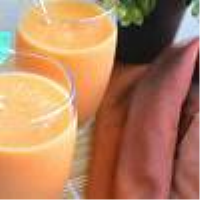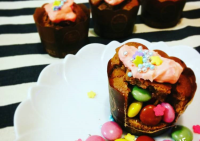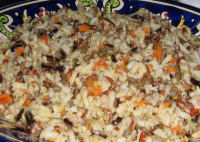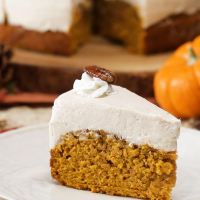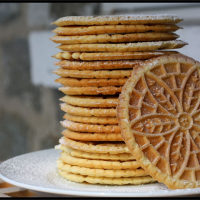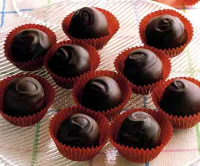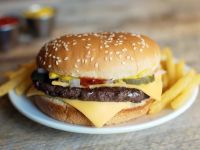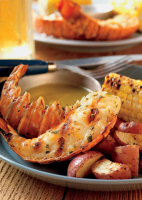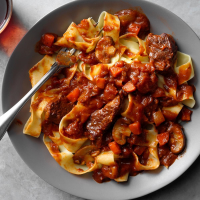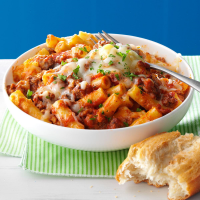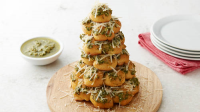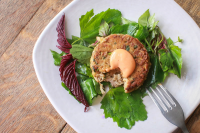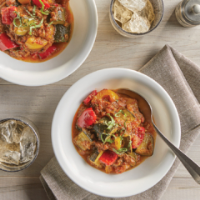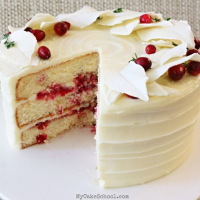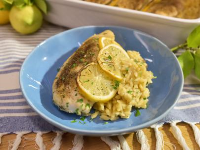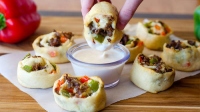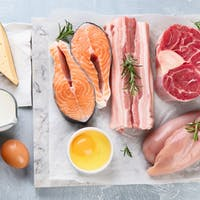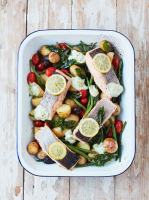THE STAGES OF MAKING CANDY | JUST A PINCH RECIPES
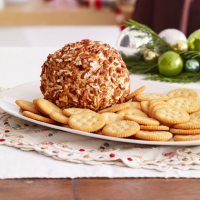
When making candy this holiday season it's always nice to have a candy thermometer but if you don't have one , These are very good steps to determine your cold water candy testing for your candy making this year.
Provided by Karla Everett @Karla59
Categories Candies
Number Of Ingredients 1
Steps:
- If you don’t have a candy thermometer, you can still make candy from sugar syrups by using the cold-water method. During the cooking stage, remove your pan from the heat and drop a small spoonful of sugar syrup into a bowl of very cold water. Immerse your hand in the cold water, try to form the sugar into a ball, and bring it out of the water. By examining the shape and texture of the resulting candy blob, you can determine the approximate temperature of your sugar. This method takes a little practice, and is not as exact as a candy thermometer, but it will do in a pinch!
- As a sugar syrup is cooked, water boils away, the sugar concentration increases, and the temperature rises. The highest temperature that the sugar syrup reaches tells you what the syrup will be like when it cools. In fact, that’s how each of the temperature stages discussed below is named.
- Thread Stage: 223-235° sugar concentration: 80% The earliest candy temperature stage is Thread Stage. At this temperature, the syrup drips from a spoon and forms thin threads in cold water.
- Soft Ball Stage: 235-245° sugar concentration: 85% The syrup easily forms a ball while in the cold water, but flattens once removed from the water. Fudge, pralines, and fondant are made by cooking ingredients to the soft-ball stage.
- Firm Ball Stage: 245-250° sugar concentration: 87% The syrup is formed into a stable ball, but loses its round shape once pressed. Caramels are cooked to the firm-ball stage.
- Hard Ball Stage: 250-266° sugar concentration: 92% The syrup holds its ball shape and deforms only slightly with very firm pressure, but remains sticky. Nougat, marshmallows, gummies, divinity, and rock candy are cooked to the hard-ball stage.
- Soft Crack Stage: 270-290° sugar concentration: 95% The syrup will form firm but pliable threads when removed from the water. Many different recipes require cooking candy to soft-crack stage, commonly including toffees, brittles, and butterscotch. Often, candies that are cooked to soft-crack stage feature a caramelized sugar flavor and a hard, pleasingly crunchy texture. Saltwater taffy and butterscotch are cooked to the soft-crack stage.
- Hard Crack Stage: 300-310° Sugar concentration: 99% The syrup will form brittle threads in the water, and will crack if you try to mold it. Toffee, nut brittles, and lollipops are all cooked to the hard-crack stage.
- Caramel Stage: 320-350° sugar concentration: 100% The sugar syrup will turn golden at this stage. Honey color produces a light caramel, while amber is a darker, fuller caramel. Anything darker than amber will result in a slightly burnt taste.
- Caramelizing Sugar: If you heat a sugar syrup to temperatures higher than any of the candy stages, you will be on your way to creating caramelized sugar (the brown liquid stage)—a rich addition to many desserts.
- Clear-Liquid Stage : 320° F sugar concentration: 100% At this temperature all the water has boiled away. The remaining sugar is liquid and light amber in color.
- Brown-Liquid Stage 338° F sugar concentration: 100% Now the liquefied sugar turns brown in color due to carmelization. The sugar is beginning to break down and form many complex compounds that contribute to a richer flavor. Caramelized sugar is used for dessert decorations and can also be used to give a candy coating to nuts.
- Burnt-Sugar Stage 350° F sugar concentration: 100% Watch out! Above about 350° F, the sugar begins to burn and develops a bitter, burnt taste.
- A candy thermometer is always the best way to go when making homemade candies so when purchasing a candy thermometer, look for one with a clear readout and an adjustable clip so it can be attached to the side of a pan. To use the thermometer, stand it upright in the candy syrup so the bulb is completely immersed in the liquid. Do not let the bulb touch the bottom of the pan. Clip it in place.
- Candy thermometers are the most accurate way of determining the temperature of boiling syrup. Always attach the thermometer to the side of the pan after washing down sugar crystals. Make sure that the thermometer does not touch the bottom of the pan. Read the thermometer at eye level. Verify the accuracy of a candy thermometer by checking its reading in boiling water. Water normally boils at 212°F at sea level. If your thermometer does not read 212°F, either you do not live at sea level or your thermometer is not accurate. (Water always boils at a lower temperature above sea level because there is less air pressure.) To adjust the temperature given on a recipe, add or subtract the difference from 212°F as needed. For example, if your thermometer reads 210°F in boiling water and the recipe temperature is 240°F, cook the candy to 238°F, or 2°F less than the temperature stated in the recipe.
MOM'S PEANUT BRITTLE | ALLRECIPES
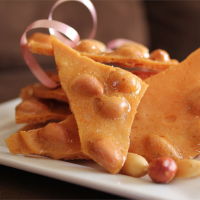
Here's the recipe my Mom has make for fifty years or so ...at least longer than my oldest sibling can remember!
Provided by Carla A.
Categories Desserts Nut Dessert Recipes Peanut Dessert Recipes
Yield 1 - 12x18 inch cookie sheet
Number Of Ingredients 9
Steps:
- Generously butter a 12x18 inch cookie sheet. Set aside.
- Mix sugar, water, and corn syrup in a heavy skillet. Stir well until it comes to a boil. Cover and boil 3 minutes. Continue to boil to hard ball stage (when a little bit dropped into a cupful of cold water forms a hard ball - hence the name!) 250 degrees F (120 degrees C).
- Stir in butter and peanuts. Continue cooking until mixture turns a light brown color. Remove from heat.
- Mix together salt, vanilla, baking soda and water. Combine this with syrup and nuts mixture. Mix well, and fast.
- Pour onto prepared cookie sheet. Use back of buttered spoon to spread thinly and evenly. Allow to cool, then break into pieces. Store in airtight container in refrigerator.
Nutrition Facts : Calories 66.8 calories, CarbohydrateContent 13.3 g, CholesterolContent 1.7 mg, FatContent 1.6 g, FiberContent 0.2 g, ProteinContent 0.5 g, SaturatedFatContent 0.6 g, SodiumContent 58.5 mg, SugarContent 10 g
HARD-BALL STAGE IN CANDY MAKING - THE SPRUCE EATS
Jan 05, 2020 · Drop a spoonful of hot syrup into a bowl of very cold water, then while it is in the water, use your fingers to gather the cooled syrup into a ball. If the hard-ball stage has been reached, the syrup will hold its ball shape and deform only slightly with very firm pressure. The ball will be quite sticky to the touch.
From thespruceeats.com
From thespruceeats.com
See details
HARD-BALL STAGE - COOKSINFO
Jun 27, 2004 · The stages of cooking sugar syrup are: 1. Thread Stage (106 – 112 C) 2. Soft-Ball Stage (112 – 116 C) 3. Firm-Ball Stage (118 – 121 C) 4. Hard-Ball Stage (121 – 130 C) 5. Soft-Crack Stage (132 – 143 C)
From cooksinfo.com
From cooksinfo.com
See details
HARD BALL STAGE - RECIPES | COOKS.COM
In 2 quart saucepan, combine ... and cook to hard ball stage, stirring only until sugar ... teaspoon onto waxed paper. 260 degrees is hard ball stage. Ingredients: 4 (sugar .. syrup .. vanilla .. whites) 9. CARAMEL SQUARES. Mix butter, flour and sugar ... boil. Cook to hard ball stage (250 degrees).
From cooks.com
From cooks.com
See details
HARD-BALL STAGE | FOOD NETWORK
hard-ball stage. A test for sugar syrup desribing the point at which a drop of boiling syrup immersed in cold water forms a rigid ball. Though the ball is hard, it will still be somewhat pliable ...
From foodnetwork.com
From foodnetwork.com
See details
SCIENCE OF COOKING: CANDY-MAKING STAGES | EXPLORATORIUM
From exploratorium.edu
See details
HARD BALL STAGE - DEFINITION AND COOKING INFORMATION ...
The stage or temperature at which a small quantity of heated sugar syrup forms a hard ball when dropped into cold water. This temperature is usually between 250°F and 265°F. A candy thermometer is a handy tool for determining the proper temperature, although experienced cooks can determine the hard-ball stage without one.
From recipetips.com
From recipetips.com
See details
SPLENDA HARD CANDY RECIPES
From tfrecipes.com
See details
CLASSIC COPYCAT CANDY RECIPES | TOP SECRET RECIPES
Apr 11, 2017 · The bars are stuck together with honey and agave syrup heated to 260 degrees F, or the hard ball stage. The sticky mixture is pressed into a 10x5-inch loaf pan, cooled, and sliced into 8 bars. The bottoms are dipped in the pure chocolate, and more is drizzled over the top.
From topsecretrecipes.com
From topsecretrecipes.com
See details
HOW TO TEST FOR STAGES OF SUGAR SYRUP - BBC FOOD
To reach the hard ball stage, continue cooking the syrup and then pour a spoonful into the bowl once more to test. It should hold together in a firm ball and will be tougher to re-shape as it cools.
From bbc.co.uk
From bbc.co.uk
See details
CANDY TEMPERATURES - SOFTBALL, HARDBALL, HARD CRACK?
Stage F C How to test; Thread: 230 degrees: degrees C: forms a short, coarse thread: Soft ball: 234 degrees: degrees C: forms a ball that flattens when removed from the water: Firm ball: 244 degrees: degrees C: forms a ball that will not flatten unless pressed: Hard ball: 250 degrees: degrees C: forms a rigid but still pliable ball: Soft Crack ...
From recipeland.com
From recipeland.com
See details
CANDY - SUGAR SYRUP TEMPERATURE CHART | CRAFTYBAKING ...
Hard-Ball Stage 250° F–268° F /121° C–131° C sugar concentration: 92% : Nougat, marshmallows, toffee, gummies, divinity, and rock candy: Hard ball: At this stage, the syrup will form thick, "ropy" threads as it drips from the spoon. The sugar concentration is rather high now, which means there’s less and less moisture in the sugar syrup.
From craftybaking.com
From craftybaking.com
See details
CANDY CANES - RECIPE | COOKS.COM
Dec 30, 2014 · Cook to 265 degrees, very hard ball stage. Remove from heat. Add peppermint. Divide mixture in half. Add food coloring to one part, pour on well greased pan or platter. Pull each part separately into ropes. Quickly wrap red part around white. Cut into 8 inch length, form into candy canes. Add review or comment.
From cooks.com
From cooks.com
See details
COOKING AND TESTING CANDY MIXTURES | BETTER HOMES & GARDENS
Jun 09, 2015 · Hard-ball stage (250 to 266 degrees F): When the ball of candy is removed from the cold water, it can be deformed by pressure, but it doesn't flatten until pressed. Soft-crack stage (270 to 290 degrees F): When dropped into the cold water, the candy separates into hard, but pliable and elastic, threads.
From bhg.com
From bhg.com
See details
FIRM-BALL STAGE - COOKSINFO
Oct 11, 2006 · If you take the ball out of the water, it will hold its shape, but it is very pliable. The Firm-Ball Stage is called for in recipes for caramels, nougats, taffy, etc. The stages of cooking sugar syrup are: 1. Thread Stage (106 – 112 C) 2. Soft-Ball Stage (112 – 116 C) 3. Firm-Ball Stage (118 – 121 C) 4. Hard-Ball Stage (121 – 130 C) 5.
From cooksinfo.com
From cooksinfo.com
See details
SOFT-BALL STAGE IN CANDY MAKING - THE SPRUCE EATS
Aug 17, 2019 · Soft-Ball Stage. Soft-ball stage refers to a specific temperature range when cooking sugar syrups, occurring between 235 and 245 F. In addition to using a candy thermometer, this stage can be determined by dropping a spoonful of hot syrup into a bowl of very cold water. In the water, use your fingers to gather the cooled syrup into a ball.
From thespruceeats.com
From thespruceeats.com
See details
HOW TO MAKE DIVINITY (CANDY) - BOULDER LOCAVORE®
Dec 17, 2019 · 250-266 degrees is Hard Ball Stage temperature. A spoon dipped into the candy mixture at this temperature will come out with a thick, ropey consistency. Hard Ball stage is the only temperature you need to know for making Divinity. The required temperature is included in the recipe card at the end of the blog post.
From boulderlocavore.com
From boulderlocavore.com
See details
SOFT-CRACK STAGE - COOKSINFO
Jun 27, 2004 · Soft-Ball Stage (112 – 116 C) 3. Firm-Ball Stage (118 – 121 C) 4. Hard-Ball Stage (121 – 130 C) 5. Soft-Crack Stage (132 – 143 C) 6. Hard-Crack Stage (149 – 154 C) Cooking Tips. High altitude: For every 300 metres (1,000 feet) that you are above sea level, subtract 1 degree C (2 degrees F) from the temperatures given in your candy recipe.
From cooksinfo.com
From cooksinfo.com
See details
A BEGINNER'S GUIDE TO MAKING THE PERFECT PEANUT BRITTLE
Dec 13, 2021 · Hard-ball stage (250?-265?) This is where you want to be when you’re making divinity, nougat, marshmallows, and gummies. The syrup will look thick and ropey as you drizzle it into the cold ...
From lifehacker.com
From lifehacker.com
See details
HOW TO TEST CANDY IN COLD WATER - MY COUNTRY TABLE
Dec 05, 2016 · Caramel, divinity, and pralines are usually cooked to a hard ball stage. Peanut Brittle is always cooked to a hard crack stage. Tips: Once you turn the heat on under your pan, it usually takes at least 3-4 minutes to bring any candy mixture to a boil over medium heat. It generally takes an additional 4-5 minutes to reach a soft ball stage.
From mycountrytable.com
From mycountrytable.com
See details
HOLIDAY CANDY MAKING | LAND O’LAKES
This stage is similar to sugar syrup rather than candy. If the candy forms a soft pliable ball, it is in the softball stage, about 235° — 240°F. This is the stage you would cook to if you are making fudge. If the candy forms a firm but not hard ball, it is in the firm ball stage. The temperature of this stage is between 242° — 248°F.
From landolakes.com
From landolakes.com
See details














